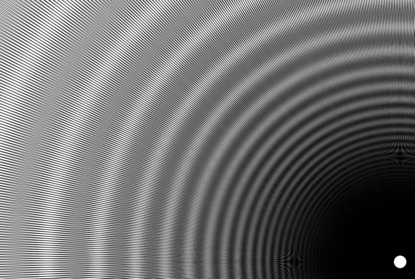Chiliagon
| Regular chiliagon | |
|---|---|
 A regular chiliagon | |
| Type | Regular polygon |
| Edgesandvertices | 1000 |
| Schläfli symbol | {1000}, t{500}, tt{250}, ttt{125} |
| Coxeter–Dynkin diagrams | |
| Symmetry group | Dihedral(D1000), order 2×1000 |
| Internal angle(degrees) | 179.64° |
| Properties | Convex,cyclic,equilateral,isogonal,isotoxal |
| Dual polygon | Self |

Ingeometry,achiliagon(/ˈkɪliəɡɒn/) or1,000-gonis apolygonwith1,000sides. Philosophers commonly refer to chiliagons to illustrate ideas about the nature and workings of thought, meaning, and mental representation.
Regular chiliagon[edit]
Aregularchiliagonis represented bySchläfli symbol{1,000} and can be constructed as atruncated500-gon, t{500}, or a twice-truncated 250-gon, tt{250}, or a thrice-truncated 125-gon, ttt{125}.
The measure of eachinternal anglein a regular chiliagon is 179°38'24 "/rad. Theareaof aregularchiliagon with sides of lengthais given by
This result differs from the area of itscircumscribed circleby less than 4parts per million.
Because 1,000 = 23× 53,the number of sides is neither a product of distinctFermat primesnor a power of two. Thus the regular chiliagon is not aconstructible polygon.Indeed, it is not even constructible with the use of an angle trisector, as the number of sides is neither a product of distinctPierpont primes,nor a product of powers of two and three. Therefore, construction of a chiliagon requires other techniques such as thequadratrix of Hippias,Archimedean spiral,or other auxiliary curves. For example, a 9° angle can first be constructed with compass and straightedge, which can then be quintisected (divided into five equal parts) twice using an auxiliary curve to produce the 21'36 "internal angle required.
Philosophical application[edit]
René Descartesuses the chiliagon as an example in hisSixth Meditationto demonstrate the difference between pure intellection and imagination. He says that, when one thinks of a chiliagon, he "does not imagine the thousand sides or see them as if they were present" before him – as he does when one imagines a triangle, for example. The imagination constructs a "confused representation," which is no different from that which it constructs of amyriagon(a polygon with ten thousand sides). However, he does clearly understand what a chiliagon is, just as he understands what a triangle is, and he is able to distinguish it from a myriagon. Therefore, the intellect is not dependent on imagination, Descartes claims, as it is able to entertain clear and distinct ideas when imagination is unable to.[1]PhilosopherPierre Gassendi,a contemporary of Descartes, was critical of this interpretation, believing that while Descartes could imagine a chiliagon, he could not understand it: one could "perceive that the word 'chiliagon' signifies a figure with a thousand angles [but] that is just the meaning of the term, and it does not follow that you understand the thousand angles of the figure any better than you imagine them."[2]
The example of a chiliagon is also referenced by other philosophers.David Humepoints out that it is "impossible for the eye to determine the angles of a chiliagon to be equal to 1.996 right angles, or make any conjecture, that approaches this proportion."[3]Gottfried Leibnizcomments on a use of the chiliagon byJohn Locke,noting that one can have an idea of the polygon without having an image of it, and thus distinguishing ideas from images.[4]Immanuel Kantrefers instead to the enneacontahexagon (96-gon), but responds to the same question raised by Descartes.[5]
Henri Poincaréuses the chiliagon as evidence that "intuition is not necessarily founded on the evidence of the senses" because "we can not represent to ourselves a chiliagon, and yet we reason by intuition on polygons in general, which include the chiliagon as a particular case."[6]
Inspired by Descartes's chiliagon example,Roderick Chisholmand other 20th-century philosophers have used similar examples to make similar points. Chisholm's "speckled hen",which need not have a determinate number of speckles to be successfully imagined, is perhaps the most famous of these.[7]
Symmetry[edit]

Theregular chiliagonhas Dih1000dihedral symmetry,order 2000, represented by 1,000 lines of reflection. Dih1000has 15 dihedral subgroups: Dih500,Dih250,Dih125,Dih200,Dih100,Dih50,Dih25,Dih40,Dih20,Dih10,Dih5,Dih8,Dih4,Dih2,and Dih1.It also has 16 morecyclicsymmetries as subgroups: Z1000,Z500,Z250,Z125,Z200,Z100,Z50,Z25,Z40,Z20,Z10,Z5,Z8,Z4,Z2,and Z1,with Znrepresenting π/nradian rotational symmetry.
John Conwaylabels these lower symmetries with a letter and order of the symmetry follows the letter.[8]He givesd(diagonal) with mirror lines through vertices,pwith mirror lines through edges (perpendicular),iwith mirror lines through both vertices and edges, andgfor rotational symmetry.a1labels no symmetry.
These lower symmetries allow degrees of freedom in defining irregular chiliagons. Only theg1000subgroup has no degrees of freedom but can be seen asdirected edges.
Chiliagram[edit]
A chiliagram is a 1,000-sidedstar polygon.There are 199 regular forms[a]given bySchläfli symbolsof the form {1000/n}, wherenis an integer between 2 and 500 that iscoprimeto 1,000. There are also 300 regularstar figuresin the remaining cases.
For example, the regular {1000/499} star polygon is constructed by 1000 nearly radial edges. Each star vertex has aninternal angleof 0.36 degrees.[b]

|
 Central area withmoiré patterns |
See also[edit]
Notes[edit]
References[edit]
- ^Meditation VIby Descartes (English translation).
- ^Sepkoski, David (2005)."Nominalism and constructivism in seventeenth-century mathematical philosophy".Historia Mathematica.32:33–59.doi:10.1016/j.hm.2003.09.002.
- ^David Hume,The Philosophical Works of David Hume,Volume 1, Black and Tait, 1826,p. 101.
- ^Jonathan Francis Bennett (2001),Learning from Six Philosophers: Descartes, Spinoza, Leibniz, Locke, Berkeley, Hume,Volume 2, Oxford University Press,ISBN0198250924,p. 53.
- ^Immanuel Kant, "On a Discovery," trans. Henry Allison, inTheoretical Philosophy After 1791,ed. Henry Allison and Peter Heath, Cambridge UP, 2002 [Akademie 8:121].
- ^Henri Poincaré (1900) "Intuition and Logic in Mathematics" in William Bragg Ewald (ed)From Kant to Hilbert: A Source Book in the Foundations of Mathematics,Volume 2, Oxford University Press, 2007,ISBN0198505361,p. 1015.
- ^Roderick Chisholm, "The Problem of the Speckled Hen",Mind51 (1942): pp. 368–373. "These problems are all descendants of Descartes's 'chiliagon' argument in the sixth of his Meditations" (Joseph Heath,Following the Rules: Practical Reasoning and Deontic Constraint,Oxford: OUP, 2008, p. 305, note 15).
- ^The Symmetries of Things,Chapter 20


